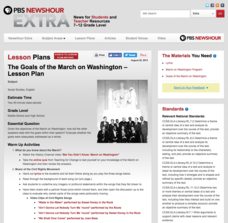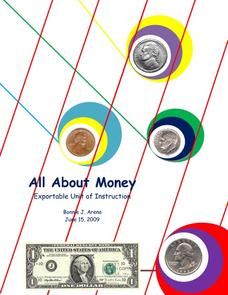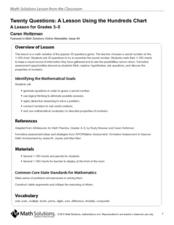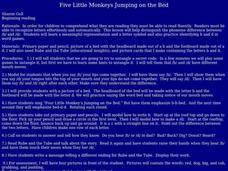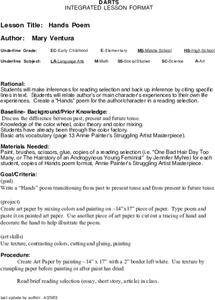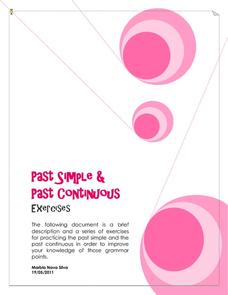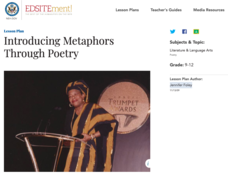Curated OER
Telling Time Worksheet: Drawing Hands on a Clock
Can your learners tell time? Give them practice with this resource. For each of nine clocks, youngsters must use the numerical time to draw the hands on the clock.
PBS
The Goals of the March on Washington
Who else had a dream other than Martin Luther King, Jr.? Pupils explore civil rights leaders in a fourth activity out of a series of five about people who paved the way to freedom for African Americans. The inquiry-based unit has your...
Curated OER
Subtraction Tables
With several numbers already filled in, this math learning exercise is sure to help your first graders with their subtraction. Three grids prompt learners to finish certain subtraction problems and fill in the answers. A great way to...
Curated OER
All About Money
Few topics engage young mathematicians as much as learning about money. Through a series of shared readings and hands-on activities, children explore the US currency system, learning how to count money and calculate change as they create...
Curated OER
Hands-On Investigation!
Learners read, analyze, and solve a mystery using problem-solving skills. They explore the History Detective website, discuss the difference between clues and red herrings, complete a dot-to-dot sheet, take notes in a detective...
Curated OER
Twenty Questions: The Hundred Chart
Use the 20 Questions game to practice math vocabulary and number properties! Project a hundreds chart and hand one out to learners. Ideally, give them counters (beans would work well) to mark off the chart so you can play multiple times....
Curated OER
"In God We Trust": The Camden Man Who Put the Missing Motto on the Dollar Bill
Here is a fascintating lesson which relates how the motto "In God We Trust" came to appear on all US currency. It turns out that a man from Arkansas came up with the idea and petioned his congressman and President Eisenhower himself to...
Curated OER
Music: Sounds on the Farm
Singing is a great way to build memory, music, and verbal communication skills. Little ones sing the song, "Old Mac Donald had a Farm." They make the sounds of each animal on the farm paying attention to signaling cues, singing high, and...
Curated OER
Conducting Research Online
In a day and age when publishing online has never been easier, high schoolers need to know how to identify a credible source. Choose the PowerPoint slides most relevant to your lesson and spend more time on the hands-on activities provided.
Curated OER
Versed on the Disadvantaged
Students reflect on what it means to help those in need, then read and analyze poetry that illustrates the struggle of poor people. They create collages connecting current issues of poverty with poets' experiences.
Curated OER
Five Little Monkeys Jumping on the Bed
Students practice discerning between the letters D and B. Through hands on activities, they recognize the difference between the commonly confused letters B and D. Students practice writing both letters and correcting common mistakes and...
Curated OER
The Real World Revisited
Class members participate in a series of hands on, online, and multimedia activities to identify the difference between primary and secondary sources. They watch a related video and visit a variety of sites to locate primary and...
Curated OER
Hands Poem
Students create a "Hands" poem for the author/character in a reading selection.They make inferences for reading selection and back up inference by citing specific lines in text. They relate author's or main character's experiences to...
Bethel School District
Observations and Inference
What's the difference between qualitative and quantitative observations? Learners make observations, inferences, and predictions about their environment with a set of questions and activities that are applicable to either language...
Curated OER
Connotation and Denotation: How Word Choice Affects a Paragraph
Review the terms denotation, connotation, diction, and mood in paragraph writing. After defining the terms, middle schoolers practice writing examples of both connotation and denotation. They complete a connotation and denotation...
MENSA Education & Research Foundation
The Writer’s Toolbox: What You Need to Master the Craft
Strengthen your high schoolers' writing with a series of steps for writing successfully. With sections on organizing an essay, choosing a topic, crafting a thesis statement, and revising a draft, the lesson encourages your class to...
Scholastic
Consider the Source
Who is more trustworthy when it comes to marijuana: a high school student, or The National Institute on Drug Abuse? Sources matter when reading informational text. Help teenagers discern which facts are true with an activity that focuses...
K12 Reader
Point of View: Who Is Telling the Story?
See how famous books of literature have different perspectives with a short worksheet. After reviewing the difference between first and third person points of view, learners look over six passages from various novels and decide...
DePaul University
Bold Plans, Big Dreams, City Progress
Determining which statements represent fact or the author's opinion in an integral part of reading informational text. Encourage seventh graders to read a passage about Barack Obama and the city of Chicago, as well as a passage focused...
Curated OER
Past Simple & Past Continuous
What is the difference between the simple past tense and the past continuous? Help your pupils master these tenses with the information and six grammar exercises included here.
Curated OER
Bouncing Pig
First graders practice discerning between the lowercase letters p and b. Through hands on and listening activities, they recognize the difference between the commonly confused letters b and p. They practice writing both letters and...
National Endowment for the Humanities
Introducing Metaphors Through Poetry
Metaphors are word pictures, creating images in our brains that draw readers to consider how two seemingly unrelated items are alike. Poems by Langston Hughes, Margaret Atwood, and Naomi Shihad Nye provide learners with an opportunity to...
Curated OER
What's the Matter? (Grades 6-7)
Students explain the physical properties of matter. They, in groups, perform a variety of experiments, each demonstrating a different property of matter. A very nice, hands-on lesson!
Star Wars in the Classroom
"Shakespeare and Star Wars": Lesson Plan Day 3
To make the point that there are many forms of language, each with its own purpose, class members select 10 lines from Doescher's play, translate these lines first into contemporary English and then into "SMS/Tweet."

